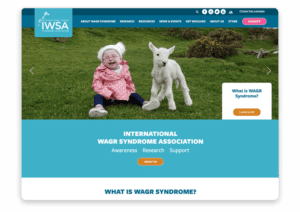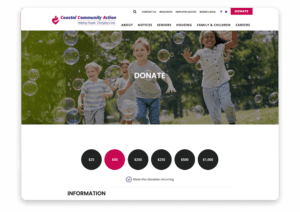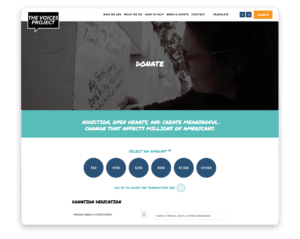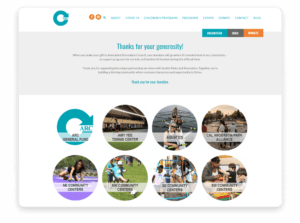Since the beginning of the COVID-19 pandemic, nonprofits are relying more and more on their website to communicate with constituents and solicit much-needed donations. With continued restrictions on in-person events, having a well-designed donation page is essential for fundraising. Here are some tips on the anatomy of a great donation page.
A good donation page will enable supporters to give to your cause but a GREAT donation page will maximize your online gifts. That’s because a well-designed donation page makes it easy and enjoyable to give more and give frequently.
Follow along to learn how to optimize your donation page and get inspired by top nonprofit organizations.
1. Include an engaging header image
Displaying too many images on your donation page is distracting and creates a cluttered look. Narrow down your content to feature one “hero shot” or photo that captures what your nonprofit is about. This photo should evoke feelings of hope and generosity to inspire potential donors to complete their gift.
Once you have decided on your hero shot, highlight it at the top of your donation page in a banner image. This will maximize its visibility without cluttering your donation page.
The International WAGR Syndrome Association has a beautiful hero shot on their donation page showcasing children with WAGR syndrome who are the core focus of their organization.
2. Offer suggested donation amounts
New donors might not know how much to give on their first time. Offering suggested amounts makes that decision a little easier and may even lead to higher donations. Set your suggested donation amounts slightly higher than your average donation. For example, if your average donation is $16, suggest donations of $20, $50, $100, and $500 for the big spenders. Of course, users should still be able to enter a custom amount, every dollar counts.
The Big Island Substance Abuse Council offers a nice range of donation amounts in an engaging and intuitive format. Donors can choose from five recommended amounts or enter their own amount.
3. Enable recurring donations
Offering a recurring donation option is the best way to build lasting relationships and increase the lifetime value of your donors. Recurring donors give an average of 42% more per year than one-time donors. The goal of any nonprofit is to foster stronger relationships with donors and convert casual supporters into loyal advocates for your cause.
Coastal Community Action offers a recurring donation checkbox to encourage donors to give monthly in support of its community initiatives. Donors can also select which program they want to support.
4. Feature donation dedications
Offering the option to dedicate a donation helps connect donors’ stories to your cause. Donation dedications can make a great gift to a friend or help honor a lost loved one. You can take it a step further by showcasing dedicated donations on your nonprofit’s website. This will help past donors feel appreciated and encourage others to give as well.
The Voices Project is a nonprofit organization advocating for recovery and support for individuals and communities struggling with addiction. The organization offers a dedication field to allow donors to dedicate their gift to people they have lost to addiction.
5. Minimize form fields
Too many fields on your donation form can be daunting for donors. They will be less likely to complete the donation process if you ask too many prying questions. Stick to just the essentials. Ask for donors’ contact information and payment details leaving any additional fields optional.
The American Friends of Covent Garden’s donation page maintains a welcoming, minimalistic feel by only asking for essential fields and arranging them in a simple format.
6. A Heartfelt Thank You
Thanking your donors is an essential step that shouldn’t be overlooked. Donors give to your nonprofit because they believe in your cause and want to help make a difference. A heartfelt thank you message lets them know that their donation is not only helpful but
appreciated too. When crafting your thank you message, be sure to include the following:
- The donor’s name
- How their donations will be used
- Links to any additional information
- Your nonprofit’s contact details
A donation receipt is also important for tax purposes. Make sure to set up automatic email confirmations so that donors can submit their receipt to claim a tax deduction.
The Associated Recreation Council of Seattle wears its heart on its sleeve with a meaningful message to donors. The organization explains how donations will be used and thanks the donor for their contribution.
The Gist
The amount of effort your nonprofit puts into its online donation page has a direct impact on the amount of funds raised. Keeping these simple best practices in mind, you can take your donation page from good to great! Check out Morweb’s list of best nonprofit websites for even more inspiration on your web design journey.











